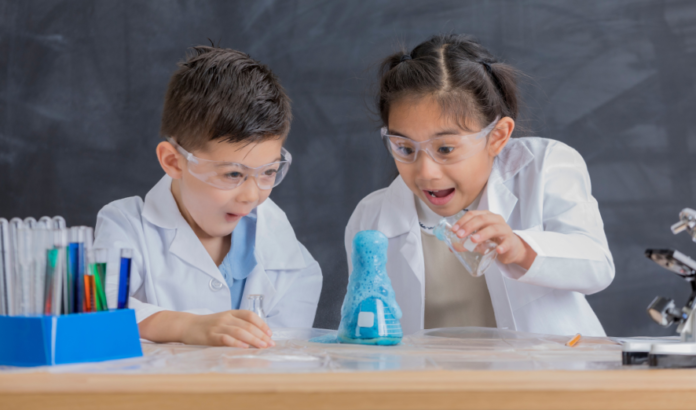learn sci doesn’t have to be confined to the classroom. By engaging in fun and simple experiments at home, you can spark curiosity and foster a love for discovery. Let’s dive into five exciting science experiments that you can easily try at home. These activities are perfect for kids and adults alike, providing a great way to learn sci something new while having a blast.
Experiment 1: Magic Milk
Materials Needed
- Whole milk
- Food coloring
- Dish soap
- Cotton swabs
- A shallow dish
Steps to Follow
- Pour enough milk into the shallow dish to cover the bottom.
- Add a few drops of different food coloring to the milk.
- Dip a cotton swab into dish soap.
- Touch the soapy swab to the center of the milk and watch the colors dance.
Scientific Explanation
Milk contains fat molecules that are disrupted by the dish soap. When the soap is added, it breaks the surface tension and interacts with the fat molecules, causing the food coloring to swirl and create a beautiful, dynamic pattern.
Experiment 2: Baking Soda Volcano
Materials Needed
- Baking soda
- Vinegar
- Dish soap
- Food coloring
- A small container
- A tray
Steps to Follow
- Place the small container on the tray.
- Fill the container with baking soda.
- Add a few drops of dish soap and food coloring to the baking soda.
- Pour vinegar into the container and watch the eruption.
Scientific Explanation
When baking soda (a base) reacts with vinegar (an acid), it produces carbon dioxide gas. The dish soap traps the gas bubbles, creating a frothy, volcanic eruption that is both educational and entertaining.
Experiment 3: Homemade Slime
Materials Needed
- White glue
- Baking soda
- Contact lens solution
- Food coloring (optional)
- Mixing bowl
Steps to Follow
- Pour a bottle of white glue into the mixing bowl.
- Add a few drops of food coloring if desired.
- Mix in a tablespoon of baking soda.
- Slowly add contact lens solution and stir until the slime begins to form.
- Knead the slime with your hands until it reaches the desired consistency.
learn sci Explanation
The contact lens solution contains borate ions, which react with the polyvinyl acetate in the glue, causing the mixture to thicken and turn into slime. This process is a great way to explore the concepts of polymers and cross-linking in chemistry.
Experiment 4: Floating Egg
Materials Needed
- Eggs
- Water
- Salt
- A large glass or container
Steps to Follow
- Fill the glass with water and gently place an egg in it. Notice that the egg sinks.
- Remove the egg and start adding salt to the water, stirring until it dissolves.
- Keep adding salt until the egg starts to float when placed in the water.
Scientific Explanation
The egg sinks in plain water because its density is higher than that of the water. By adding salt, you increase the density of the water, making it denser than the egg, which causes the egg to float. This experiment demonstrates the principles of density and buoyancy.
Experiment 5: Invisible Ink
Materials Needed
- Lemon juice
- Water
- Cotton swabs
- White paper
- A heat source (lamp or iron)
Steps to Follow
- Mix equal parts lemon juice and water in a small bowl.
- Use a cotton swab to write a message on the white paper with the lemon juice mixture.
- Allow the paper to dry completely.
- To reveal the message, gently heat the paper by holding it near a light bulb or using an iron on low heat.
Scientific Explanation
Lemon juice oxidizes and turns brown when heated. The heat causes the organic compounds in the lemon juice to decompose, revealing the hidden message. This experiment is a fun introduction to the concept of chemical reactions.
Safety Tips for Home Experiments
- Always supervise children during experiments.
- Use appropriate protective gear, such as gloves and goggles.
- Ensure good ventilation when working with chemicals.
- Keep a first-aid kit nearby.
- Clean up thoroughly after each experiment.
The Educational Value of Science Experiments
Science experiments at home are more than just fun activities; they are powerful educational tools. They encourage hands-on learning, critical thinking, and problem-solving skills. By conducting experiments, learners can see scientific concepts in action, making abstract ideas more concrete and understandable.
These activities also foster curiosity and a love for discovery, which are essential for lifelong learning. Whether you’re a parent looking to engage your child in educational activities or simply someone who enjoys exploring new ideas, these experiments provide a fantastic way to learn and have fun at the same time.
Conclusion
Engaging in learn sci experiments at home is a wonderful way to learn new concepts and enjoy the process of discovery. From creating a magical milk display to erupting a homemade volcano, these activities are sure to inspire and educate. So gather your materials, follow the steps, and dive into the world of learn sci with enthusiasm and curiosity.




















